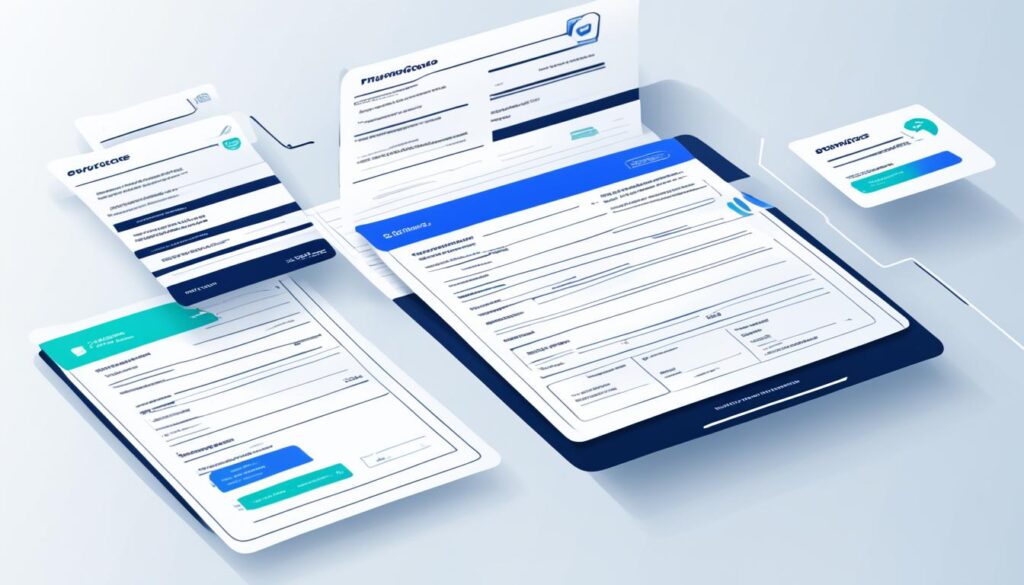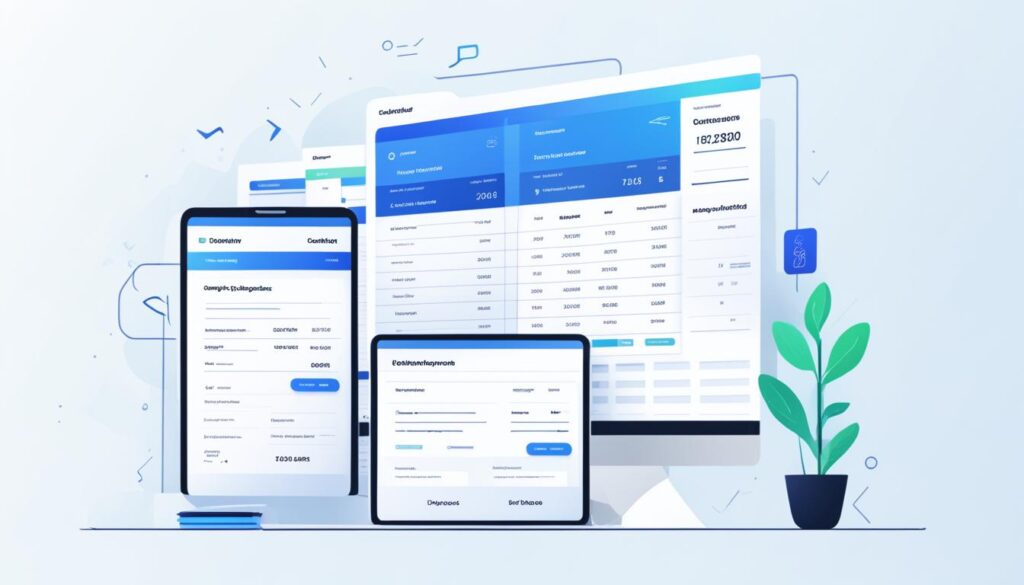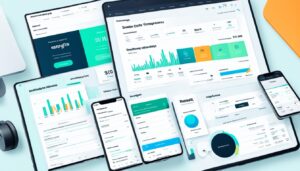Manual invoice processing can be time-consuming, inefficient, and prone to errors. Invoice automation streamlines the invoice processing tasks, including receiving and scanning invoices, extracting data, matching invoices to purchase orders, approving invoices, and paying invoices. Benefits of invoice automation include optimizing cash flow, minimizing the risk of human errors, achieving significant cost savings, improving accuracy, increasing visibility, reducing fraud, and improving compliance. Manual invoice processing can cost businesses an average of $10.18 per invoice. Invoice automation software, such as Fusion Inventory Management, helps automate the entire invoicing workflow, from receiving invoices to making payments. It digitizes invoice creation and increases the accuracy and efficiency of the invoice payment process.
Key Takeaways:
- Invoice and payment automation streamline manual invoice processing tasks.
- Benefits of invoice automation include optimized cash flow, cost savings, improved accuracy, and increased visibility.
- Invoice automation software, such as ProcureDesk, digitizes invoice collection and automates the invoicing workflow.
- Manual invoice processing can cost businesses an average of $10.18 per invoice.
- Automating the invoice payment process improves efficiency and reduces errors.
The Importance of Invoice Automation
Invoice automation plays a crucial role in improving the efficiency of invoice processing for businesses. By streamlining invoice management and accelerating payment processing, invoice automation offers a range of benefits that contribute to a healthier financial ecosystem.
- Efficient invoice processing: Invoice automation optimizes the entire invoice processing workflow, from data entry to invoice matching. By automating these tasks, businesses can significantly reduce manual effort and minimize human errors.
- Improved cash flow: By streamlining invoice management and payment processing, invoice automation helps improve cash flow in two ways. First, it ensures that invoices are processed and paid in a timely manner, allowing businesses to uphold their financial commitments. Second, it provides better cash flow management by allowing businesses to track and plan their payments more effectively.
- Cost savings: Invoice automation delivers significant cost savings by eliminating the need for manual data entry and reducing error-related expenses. Businesses can save on labor costs and avoid costly mistakes that often arise from manual processing.
- Increased accuracy: Manual invoice processing can be prone to errors, such as data entry mistakes or mismatched invoices. Invoice automation leverages technology, such as optical character recognition (OCR), to extract data accurately and match invoices with purchase orders. This enhanced accuracy leads to fewer processing errors and increased operational efficiency.
- Enhanced visibility: Invoice automation provides businesses with real-time visibility into their invoice processing workflows. Through a centralized system, businesses can track the status of invoices, identify bottlenecks, and make data-driven decisions to improve their processes.
- Fraud reduction: By automating tasks prone to human error, such as data entry and invoice archiving, invoice automation helps minimize the risk of fraud. The system applies consistent controls and ensures compliance with financial regulations, reducing the likelihood of fraudulent activities.
- Compliance: Invoice automation software enables businesses to automate tasks required for compliance, such as invoice archiving and record-keeping. By automating these processes, businesses can ensure they meet regulatory requirements and maintain accurate financial records.
Invoice automation is not just a time-saving solution, but an essential tool that promotes efficiency, accuracy, and compliance in invoice processing. By adopting invoice automation, businesses can improve their cash flow, minimize errors, lower costs, and enhance their overall financial performance.
Implementing an invoice automation solution, such as ProcureDesk, enables businesses to optimize their accounts payable processes and reap the benefits of streamlined, efficient invoice management.
| Benefits of Invoice Automation |
|---|
| Efficient invoice processing |
| Improved cash flow management |
| Cost savings through reduced errors |
| Increased accuracy in invoice processing |
| Enhanced visibility into invoice workflows |
| Fraud reduction through automated controls |
| Compliance with financial regulations |
The Cost of Manual Invoice Processing
Manual invoice processing can have significant cost implications for businesses. It requires skilled employees to perform tasks such as data entry, matching invoices to purchase orders, and approving payments, leading to high labor costs.
Manual processing is also prone to errors, resulting in costly mistakes such as late payments, duplicate payments, and overpayments. Moreover, manual processing can lead to slow processing times, damaging relationships with vendors and impacting cash flow.
According to a study by Ardent Partners, the average cost to process a single invoice is $10.18, which has increased by 10% in the past year. The high cost of manual processing highlights the need for invoice automation to reduce expenses and improve efficiency.
| Cost Category | Manual Invoice Processing | Automated Invoice Processing |
|---|---|---|
| Labor Costs | High, due to skilled employees required for manual tasks | Reduced, as automation eliminates the need for manual labor |
| Errors | Prone to errors, resulting in costly mistakes | Minimized, as automation improves accuracy and reduces human errors |
| Processing Times | Slow, potentially damaging vendor relationships and cash flow | Accelerated, enabling faster invoice processing and payments |
By implementing an automated invoice processing system, businesses can reduce costs, minimize errors, improve processing times, and maintain positive relationships with vendors. Invoice automation software streamlines the entire invoicing workflow, from receiving invoices to making payments, resulting in cost savings, increased efficiency, and enhanced financial management.
How Invoice Automation Works
Invoice automation utilizes software to automate various tasks involved in invoice processing. By leveraging advanced technologies, businesses can streamline their entire invoicing workflow, improve efficiency, reduce errors, and enhance productivity. Let’s take a closer look at how invoice automation works:
1. Electronic Invoice Receipt
The process begins with the electronic receipt of invoices. Instead of relying on traditional paper-based invoices, businesses receive invoices digitally, either via email or through an online portal. This eliminates the need for manual handling and ensures faster invoice processing.
2. Data Extraction and Validation
Invoice automation software employs advanced optical character recognition (OCR) technology to extract relevant data from the invoices. The OCR technology accurately captures information such as invoice number, date, line items, and relevant details. The extracted data is then validated to ensure accuracy and completeness.
3. Matching Invoices to Purchase Orders
Once the data is extracted and validated, the automation software matches the invoices with the corresponding purchase orders and verifies the accuracy of the information. This automated matching process ensures that invoices are properly aligned with the goods or services received.
4. Approval and Payment Automation
After matching the invoices with the purchase orders, the automation software routes the invoices to the appropriate individuals or departments for approval. This eliminates the need for manual routing and ensures that invoices are reviewed and approved in a timely manner. Once approved, the software automates the payment process, initiating the transfer of funds to the vendor.
5. Streamlined Workflow
One of the key benefits of invoice automation is its ability to streamline the entire invoicing workflow. By automating repetitive and manual tasks, businesses can accelerate invoice processing and minimize the risk of human errors. This leads to faster payments, improved cash flow, and enhanced vendor relationships.
By harnessing the power of software automation, businesses can transform their invoice processing tasks, reduce costs, improve accuracy, and optimize their invoicing workflow. Invoice automation provides a seamless and efficient solution for managing invoices, making it an essential tool for organizations of all sizes.
| Benefits of Invoice Automation |
|---|
| Improved efficiency and productivity |
| Reduced errors and discrepancies |
| Faster invoice processing and payment |
| Enhanced cash flow management |
| Streamlined approval and payment workflows |
By implementing invoice automation software, businesses can unlock a wide range of benefits, ranging from increased efficiency to improved cash flow management. The automation of invoice processing tasks eliminates manual errors, speeds up payment processes, and streamlines the entire workflow. Don’t miss out on the advantages provided by invoice automation – embrace this technology to transform your invoicing operations and drive success for your business.
Best Practices for Accounts Payable Efficiency
Optimizing the accounts payable process is essential for businesses to achieve maximum efficiency and streamline invoice processing. By implementing the following best practices, businesses can improve their accounts payable operations and enhance overall financial management:
1. Electronic Payments
Transitioning from paper checks to electronic payments is a key step in improving accounts payable efficiency. Electronic payments eliminate the need for manual processing and allow for faster payment processing times. This not only reduces the reliance on physical checks but also minimizes the risk of errors and delays associated with traditional payment methods.
2. Standardized Workflows
By standardizing accounts payable workflows, businesses can establish consistent processes for invoice handling across the organization. Standardization ensures that invoices are processed in the same manner, reducing confusion and increasing efficiency. It also helps identify bottlenecks and areas for improvement in the invoice processing workflow.
3. Building Strong Vendor Relationships
Developing and maintaining strong vendor relationships is crucial for efficient accounts payable management. Strong relationships can lead to better terms, favorable pricing, and timely payments. Clear and open communication with vendors helps ensure accurate invoice processing and reduces the likelihood of disputes or errors.
4. Taking Advantage of Early Payment Discounts
Businesses should actively seek opportunities to take advantage of early payment discounts offered by vendors. Paying invoices ahead of the due date can result in cost savings and improved cash flow. By closely monitoring payment terms and prioritizing early payment, businesses can optimize their accounts payable process and reduce expenses.
5. Monitoring Accounts Payable KPIs
Measuring and tracking key performance indicators (KPIs) is essential for assessing the performance of the accounts payable function. KPIs such as invoice processing time, payment accuracy, and payment cycle time provide insights into efficiency and identify areas for improvement. Regularly monitoring these KPIs helps optimize the accounts payable process and drive better financial outcomes.
6. Automating Accounts Payable Processes
Implementing AP automation software can significantly streamline the entire invoicing workflow. AP automation eliminates manual data entry and automates tasks such as invoice matching and approval processes. By reducing human intervention, businesses can minimize errors, improve process efficiency, and enhance overall accounts payable performance.
7. Running Reports for Visibility
Regularly running reports on accounts payable activities provides visibility and insights into invoice processing and payment performance. Detailed reports help identify trends, track payment status, and identify areas for improvement. With accurate and up-to-date information, businesses can make data-driven decisions and optimize their accounts payable operations.
8. Strategic Approach to Accounts Payable
Adopting a strategic approach to accounts payable involves continuous improvement and proactive management. Businesses should analyze their AP processes, identify inefficiencies, and implement process optimizations. A strategic approach focuses on long-term goals, compliance, risk management, and overall effectiveness.
9. Supplier Portals for Enhanced Collaboration
Using supplier portals can streamline communication and collaboration between businesses and vendors. Supplier portals provide a centralized platform for invoice management, document sharing, and invoice tracking. By leveraging supplier portals, businesses can enhance visibility into the accounts payable process and improve collaboration with vendors.
10. Embracing a Hybrid Work Environment
In today’s digital era, businesses can optimize accounts payable efficiency by embracing a hybrid work environment. Allowing employees to work remotely or in-office as needed increases flexibility and accessibility. Embracing digital tools and cloud-based solutions for invoice processing ensures smooth operations, regardless of the physical work location.
By implementing these best practices, businesses can establish efficient and effective accounts payable processes. Enhanced accounts payable efficiency leads to timely payments, reduced errors, improved vendor relationships, cost savings, and overall financial health.
Creating an Efficient Invoice Payment Process
Streamlining the invoice payment process is crucial for efficient accounts payable management. By implementing the following strategies, businesses can enhance their invoice payment process, improve accuracy, and reduce delays:
1. Centralized Email Address:
Creating a centralized email address for invoice-related communication ensures that all invoices are received in one location. This allows for easier tracking and organization of invoices, minimizing the risk of missing payments or overlooking important invoices.
2. Triage Team:
Assigning an email triage team responsible for monitoring and delegating incoming invoices can help streamline the processing workflow. The triage team can review incoming invoices, categorize them based on their urgency or department, and direct them to the appropriate individuals or departments for further action.
3. Approval Systems:
To prevent errors and fraud, businesses should establish approval systems based on departments and locations. This ensures that invoices are reviewed and approved by the relevant individuals with the necessary expertise and authority. By automating the approval process, businesses can reduce delays and improve accuracy.
4. Company Policies:
Enforcing clear company policies regarding invoice payments ensures consistency and timely payments. These policies should outline payment terms, procedures, and any specific requirements for invoice submission. Clear guidelines help both the accounts payable team and vendors understand the payment process, reducing confusion and delays.
5. Centralized Invoice Processing:
Centralizing invoice processing in a single system or platform increases efficiency and provides easy access to all invoices. This allows for streamlined tracking, monitoring, and retrieval of invoice information, reducing the time required for invoice management and payment processing.
6. AP Automation:
Utilizing AP automation software, such as PaperTrl, can further streamline the invoice payment process. AP automation software automates the workflow by digitizing and automating tasks such as invoice data extraction, verification, approval routing, and payment processing. By leveraging AP automation, businesses can significantly reduce errors, enhance efficiency, and improve the overall accuracy of the invoice payment process.
By implementing these strategies and leveraging AP automation software, businesses can create an efficient invoice payment process that not only improves accuracy and reduces delays but also enhances overall accounts payable management.
| Benefits of Creating an Efficient Invoice Payment Process |
|---|
| 1. Improved accuracy in payment processing |
| 2. Reduced delays in invoice payment |
| 3. Enhanced visibility and control over invoice management |
| 4. Minimized risk of errors and fraud |
| 5. Consistent adherence to company policies and procedures |
| 6. Streamlined tracking and monitoring of invoices |
By creating an efficient invoice payment process, businesses can improve their accounts payable operations, enhance financial management, and build stronger relationships with vendors and suppliers.
The Benefits of Invoice Payment Automation
Invoice payment automation brings a multitude of benefits to businesses, offering streamlined processes, reduced errors, and timely payments. By implementing AP automation software, companies can revolutionize their invoice payment workflows, leading to improved financial management and increased efficiency.
One significant advantage of invoice payment automation is the ability to streamline processes. By automating tasks such as data entry, invoice matching, and payment approvals, businesses can eliminate manual inefficiencies and accelerate the payment process. This streamlining minimizes bottlenecks and eliminates delays, ensuring that payments are made in a timely manner and enhancing overall productivity.
Moreover, automating the invoice payment process reduces errors. Manual processing is vulnerable to human mistakes, which can lead to costly errors such as incorrect payment amounts or missed payment deadlines. Invoice payment automation significantly reduces the risk of these errors by automating the entire payment workflow, from receiving invoices to making payments. This not only improves accuracy but also saves valuable time that would otherwise be spent on manual error correction.
In addition to streamlining processes and reducing errors, invoice payment automation improves vendor relationships. Accurate and timely payments strengthen vendor satisfaction, foster trust, and lead to better partnerships. Consistently paying vendors on time enhances business reputation and credibility, ultimately benefiting both parties involved in the transaction.
Another key benefit of invoice payment automation is cost savings. By automating invoice processing and payment, businesses can reduce labor costs associated with manual data entry, invoice matching, and payment reconciliation. Moreover, the increased efficiency gained through automation minimizes the risk of late payment fees, duplicate payments, and other costly errors, resulting in significant cost savings over time.
AP automation software provides an audit trail of all invoice activities, ensuring transparency and accountability. This audit trail offers a comprehensive record of every step in the invoice payment process, providing businesses with an easily accessible and verifiable history of their financial transactions. Having an audit trail enhances financial transparency and simplifies compliance with regulatory requirements, facilitating accurate reporting and improving financial governance.
Key Benefits of Invoice Payment Automation:
- Streamlined processes for faster payment processing
- Reduced errors through automated workflows
- Timely payments to improve vendor relationships
- Cost savings through minimized labor costs and improved efficiency
- Audit trail for enhanced transparency and accountability
By embracing invoice payment automation and leveraging AP automation software, businesses can unlock the full potential of their invoice payment processes. The benefits extend beyond improved efficiency and reduced errors to include strengthened vendor relationships, cost savings, and enhanced financial management. Take advantage of invoice payment automation today and reap the rewards of a streamlined and efficient payment process.

Enhancing Accounts Payable with AP Automation Software
Utilizing AP automation software can greatly enhance the efficiency and effectiveness of your accounts payable processes. By automating various tasks and optimizing workflows, businesses can streamline invoice processing, improve cash flow analysis, reduce compliance risk, and gain access to advanced reporting and analytics.
AP automation software eliminates the need for manual data entry, reducing the risk of errors and saving valuable time. With automated accounts payable processes, invoices can be accurately captured, validated, and processed in a fraction of the time it takes manually. This improved efficiency allows businesses to allocate resources more effectively and focus on other critical areas of their operations.
In addition to process optimization, AP automation software enables businesses to gain valuable insights into their cash flow. By analyzing and tracking payment trends and patterns, businesses can effectively plan and manage their cash flow, ensuring timely payments and reducing the risk of late fees or penalties. Cash flow analysis tools provided by AP automation software can help businesses make informed decisions and improve their overall financial health.
AP automation software also plays a crucial role in reducing compliance risk. By automating regulatory processes and ensuring adherence to financial regulations, businesses can minimize the risk of non-compliance and associated penalties. Advanced reporting and analytics capabilities provided by AP automation software enable businesses to generate comprehensive reports, monitor key performance indicators, and demonstrate accurate financial records for audits.
Implementing AP automation software streamlines accounts payable processes, optimizing efficiency, reducing errors, improving cash flow analysis, and minimizing compliance risk.
In summary, adopting AP automation software revolutionizes the accounts payable process. It automates tasks, optimizes workflows, improves data accuracy, and provides advanced reporting and analytics capabilities. By enhancing accounts payable with AP automation software, businesses can streamline their operations, improve financial management, and boost overall efficiency.
Benefits of AP Automation Software
| Benefits | Description |
|---|---|
| Streamlined Processes | Automating tasks and optimizing workflows result in streamlined accounts payable processes. |
| Reduced Errors | Automation reduces the risk of manual data entry errors, improving data accuracy. |
| Improved Cash Flow Analysis | AP automation software provides tools for analyzing and planning cash flow effectively. |
| Minimized Compliance Risk | Automating regulatory processes ensures compliance with financial regulations. |
| Advanced Reporting and Analytics | AP automation software offers comprehensive reporting and analytics capabilities for better financial insights. |
The Role of PaperTrl in Automating the AP Process
PaperTrl is a cloud-based AP automation software solution that revolutionizes the accounts payable (AP) process. By automating the entire AP workflow, from the procurement stage to invoice management and payment processing, PaperTrl simplifies and streamlines critical tasks, reducing processing time, minimizing human errors, and improving overall efficiency.
With PaperTrl’s intuitive cloud-based platform, businesses can digitize and centralize their AP processes, eliminating the need for manual paper-based tasks. This powerful solution brings numerous benefits to businesses, including:
- Streamlined Review and Approvals: PaperTrl enables businesses to automate the review and approval processes, ensuring quicker turnaround times and minimizing delays in invoice processing.
- Reduced Processing Time and Associated Costs: By automating repetitive tasks and workflows, PaperTrl significantly reduces the time and effort required to process invoices, leading to cost savings for the business.
- Minimized Potential for Human Error: Manual data entry and processing are prone to errors, which can result in payment delays, discrepancies, and financial losses. PaperTrl’s automation capabilities minimize the risk of human error, ensuring accuracy and reducing the need for manual intervention.
In addition to these benefits, PaperTrl offers a range of features designed to enhance the AP process. The software allows businesses to digitize and store invoices in a secure digital format, enabling easy accessibility and eliminating the risk of document loss. Furthermore, PaperTrl maintains a detailed audit trail, providing transparency and accountability throughout the entire AP process.
“PaperTrl simplifies and streamlines critical tasks, reducing processing time, minimizing human errors, and improving overall efficiency.”
By leveraging PaperTrl’s cloud-based solution, businesses can optimize their AP operations, improve efficiency, and gain better control over their financial processes. With its user-friendly interface and powerful automation capabilities, PaperTrl empowers businesses to embrace a more streamlined and effective approach to AP management.
Engaging the Entire Company in Streamlining the Invoice Payment Process
Streamlining the invoice payment process is a collective effort that involves engaging the entire company, not just the accounts payable team. By fostering company-wide collaboration and educating employees about the importance of timely and accurate invoice processing, businesses can achieve significant improvements in their invoice payment process.
Reducing errors and improving efficiency in the invoice payment process can be accomplished through the adoption of invoice payment technology, such as AP automation software. By implementing AP automation, businesses can enhance communication, minimize errors, and streamline the invoice payment process across the organization.
Engaging the entire company in streamlining the invoice payment process brings several benefits, including:
- Improved accuracy in invoice processing
- Reduced payment errors
- Efficient utilization of invoice payment technology
- Enhanced collaboration between departments
- Streamlined approval workflows
Bringing together different teams within the organization, such as finance, procurement, and operations, can help identify areas for improvement and implement effective strategies to optimize the invoice payment process.
Open communication and continuous training programs are essential to ensure that employees across the company understand the importance of accurate and timely invoice processing. By providing regular updates on the invoice payment process and offering training sessions on invoice automation tools and practices, businesses can promote a culture of efficiency and excellence in the entire organization.
Secure Your Business’s Financial Health with Invoice Payment Automation
Implementing invoice payment automation is crucial for securing your business’s financial health. By streamlining your accounts payable processes and adopting invoice payment technology, you can effectively reduce the risk of fraudulent payments, ensure accurate and timely payments, and protect your company’s credit score.
Automated payment systems provide robust safeguards against fraudulent activities, such as unauthorized payments or duplicate invoices. These systems improve payment accuracy by eliminating human errors and facilitating timely payments to vendors, thereby strengthening your business relationships and maintaining a positive cash flow.
With invoice payment automation, you can enhance the security and efficiency of your invoice payment processes. Automated software solutions use advanced technologies like encryption and secure portals to safeguard invoice data during transmission and storage. This significantly reduces the risk of data breaches and unauthorized access, protecting your business from financial and reputational damage.
Key Benefits of Implementing Invoice Payment Automation:
- Fraud prevention: Automated payment systems provide robust safeguards against fraudulent activities, protecting your business from financial losses.
- Accurate payments: By eliminating manual data entry and human errors, invoice payment automation ensures that your payments are made accurately, reducing invoice processing disputes and correcting payment errors.
- Timely payments: Automated payment systems expedite the payment process, ensuring that your vendors receive payments on time, which strengthens your business relationships.
- Invoice payment security: Invoice payment automation utilizes secure technology and encryption protocols to protect your invoice data from unauthorized access or data breaches.
- Increased efficiency: Automating the invoice payment process reduces manual effort, allowing your accounts payable team to focus on more strategic tasks and improving overall efficiency.
Securing your business’s financial health through invoice payment automation is a proactive measure that prevents financial losses, improves payment accuracy, and strengthens your business relationships. By optimizing your accounts payable processes, you can maintain a healthy cash flow, protect your credit score, and position your business for long-term success.
Real-Life Example: XYZ Corporation
XYZ Corporation, a leading manufacturing company, recognized the importance of secure invoice payment processes to maintain their financial health. By implementing invoice payment automation, they were able to reduce the risk of fraudulent payments and achieve accurate and timely payments to their vendors.
With automated payment systems and robust security measures in place, XYZ Corporation improved their accounts payable efficiency, minimized the risk of payment errors, and strengthened their vendor relationships. By streamlining their invoice payment processes, they optimized their cash flow, reduced compliance risks, and protected their company’s financial well-being.
Don’t let your business’s financial health be compromised by inefficient and insecure invoice payment processes. Embrace invoice payment automation to secure your payments, streamline your accounts payable processes, and safeguard the financial stability of your business.
Invoice and Payment Automation Recap
Invoice and payment automation brings numerous benefits to businesses, improving accounts payable efficiency and optimizing processes. By implementing AP automation software, such as ProcureDesk or PaperTrl, businesses can streamline their entire invoicing workflow, from invoice receipt to payment processing.
The advantages of invoice and payment automation are significant. Businesses can experience streamlined processes, reduced errors, improved cash flow, and enhanced visibility into invoice processing workflows. Through automated data entry and invoice matching, businesses can optimize their accounts payable efficiency, leading to increased cost savings.
AP automation software not only eliminates manual tasks but also revolutionizes billing processes, allowing for faster, more accurate, and efficient payment processing. By digitizing and automating invoice management, businesses can transform their invoice processing and improve their bottom line. Experience the benefits of invoice and payment automation today to take your invoice management processes to the next level.
Learn More About Amazon Financials
What is invoice and payment automation?
Invoice and payment automation refers to the use of software and technology to streamline the invoicing and payment processes. It involves automating tasks such as receiving and scanning invoices, extracting important data, matching invoices to purchase orders, approving payments, and making payments.
What are the benefits of invoice automation?
Invoice automation offers several benefits, including optimizing cash flow, minimizing human errors, achieving significant cost savings, improving accuracy, increasing visibility, reducing fraud, and improving compliance.
What is the cost of manual invoice processing?
Manual invoice processing can cost businesses an average of .18 per invoice, which includes labor costs and the potential for errors resulting in costly mistakes such as late payments, duplicate payments, and overpayments.
How does invoice automation work?
Invoice automation uses software to automate tasks involved in the invoice processing workflow, such as receiving invoices electronically, extracting data from invoices using OCR technology, verifying and matching invoice data to purchase orders, and automating approval and payment processes.
What are some best practices for accounts payable efficiency?
Best practices for accounts payable efficiency include making electronic payments, standardizing accounts payable workflows, building strong vendor relationships, taking advantage of early payment discounts, monitoring accounts payable KPIs, automating accounts payable processes, running regular reports, taking a strategic approach to accounts payable, utilizing supplier portals, and embracing a hybrid work environment.
How can I create an efficient invoice payment process?
To create an efficient invoice payment process, you can create a centralized email address for invoice-related emails, assign an email triage team, set up approval systems based on departments and locations, enforce company policies, centralize invoice processing in a single system, and utilize AP automation software such as PaperTrl.
What are the benefits of invoice payment automation?
Invoice payment automation offers benefits such as streamlined processes, reduced errors, timely payments, improved vendor relationships, cost savings, increased efficiency, and an audit trail of all invoice activities.
How does AP automation software enhance accounts payable?
AP automation software enhances accounts payable by automating tasks, optimizing workflows, reducing manual data entry, improving cash flow analysis and planning, ensuring compliance with regulations, reducing the risk of errors, improving data accuracy, and simplifying financial management.
What is the role of PaperTrl in automating the AP process?
PaperTrl is a cloud-based AP automation software solution that automates the entire accounts payable process, from purchasing to payments. It simplifies and streamlines review and approvals, reduces processing time and associated costs, and minimizes the potential for human error. PaperTrl digitizes AP processes, stores invoices digitally, and provides a detailed audit trail.
How can I engage the entire company in streamlining the invoice payment process?
Engaging the entire company in streamlining the invoice payment process involves fostering company-wide collaboration, educating employees about the importance of timely and accurate invoice processing, and implementing invoice payment technology such as AP automation software.
Why is invoice payment automation important for securing my business’s financial health?
Invoice payment automation is important for securing your business’s financial health as it reduces the risk of fraudulent payments, ensures accurate and timely payments, protects the company’s credit score, and enhances the security and efficiency of the invoice payment processes.
What are the benefits of invoice and payment automation?
Invoice and payment automation offer benefits such as streamlined processes, reduced errors, improved cash flow, enhanced visibility into invoice processing workflows, increased efficiency, and improved overall financial management.




